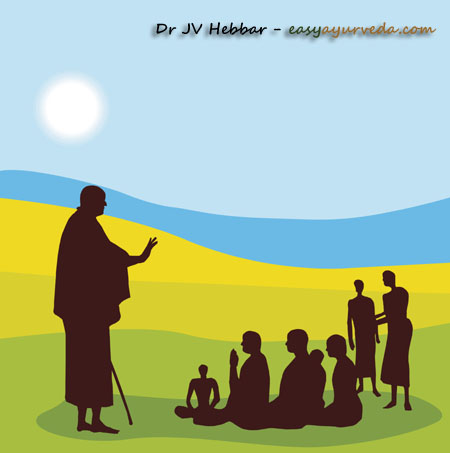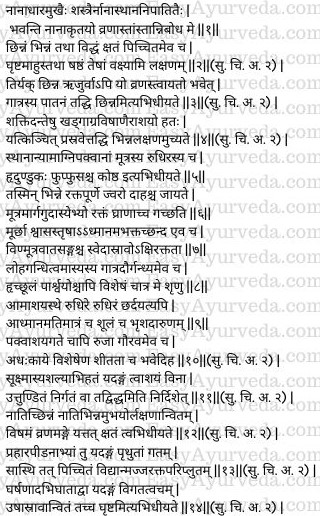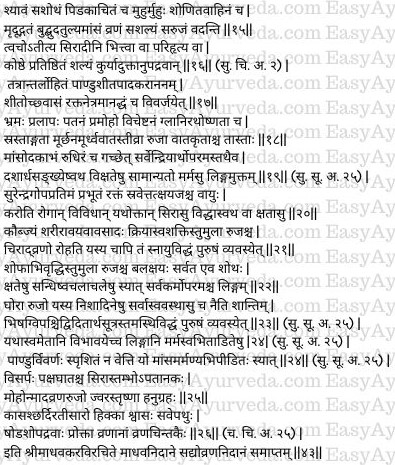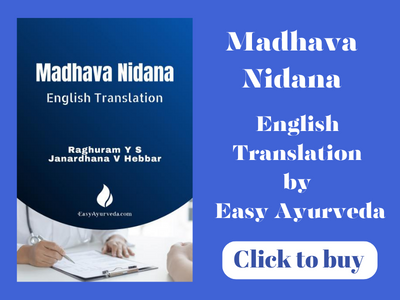Madhava Nidana Chapter 43 Sadyo Vrana Nidanam
This article explains Madava nidana 43rd chapter “Sadyo Vrana Nidanam”. Causes, types, symptoms and complications of Sadyo vrana are explained in this chapter.

Table of Contents
Sadyo Vrana Hetu
Causative factors
Different kinds of ulcers having different shapes, caused by assault with different types of sharp weapons having different kinds of edges, in different places of the body are described further on. (1)
Types of ulcers based on the shapes (appearance)
Below mentioned are the six kinds of ulcers –
- Chinna – incised wound)
- Bhinna – puncture wound
- Viddha – stabbed wound
- Ksata – lacerated wound
- Piccita – crushed wound and
- Ghrsta – excoriated
The features of these ulcers shall be henceforth explained. (2)
Read – Charaka Vrana Chikitsa – 25th Chapter – Wounds, Ulcers
Chinna Vrana
In Chinnavraņa the wound is either curved or straight and also wide. The organ or the part of the body which has been mutilated hangs from the wound or even may fall off. (3)
Bhinna Vrana
Bhinna vraņa is a puncture wound. It is caused by pointed javelin, teeth / tusk, arrow / spear, the pointed end of the sword or horns of animals. When these enter and damage the interiors of different visceral organs, ulcers (punctured) are formed. This would lead to discharge of various materials depending on the organ which has been punctured. (4)
Definition of Koshta (hollow viscera which would hold many visceral organs) and symptoms of puncture of various visceral organs
The organs or seats of ama (undigested food i.e., stomach), agni (digestive juices / enzymes i.e., duodenum, liver, gallbladder and pancreas together), pakva ahara (digested food i.e., intestines / colon), mutra (urine i.e., urinary bladder), and rudhira (blood i.e., liver and spleen), along with hrdaya (heart), unduka (caecum), phuppusa / fupfusa (lungs) are known as kostha (abdominal viscera / visceral space which lodges the mentioned organs). A Puncture wound into the kostha will cause accumulation of blood in the injured organs which leads to manifestation of fever and burning sensation. Bleeding will occur through urethra, anus or nose.
The other general symptoms of puncture to the koshta are fainting (losing consciousness), dyspnoea (increased / difficult respiration), thirst, distension of the abdomen, loss of taste (aversion towards food), obstruction to the movement (expulsion) of urine, faeces and flatus, excessive sweating, redness of the eyes, smell of iron from the mouth, foul smell emitted from the body and pain in the heart and flanks. (5-8)
Read – Koshta: Understanding Gut Behaviour And Gut Reactivity
Symptoms of puncture of specific organs
If amashaya (stomach) is punctured, blood accumulates in the stomach and there will be vomiting of blood, severe distension of abdomen and severe pain in the abdomen.
If pakvaashaya (small and large intestines, mainly colon) is punctured there will be severe pain, heaviness and coldness of the lower extremities. (9-10).
Viddha Vrana
Viddha vrana (stab / puncture wound) is that caused by a pointed instrument, on other body parts, away from any viscera (viscera not involved). Viddha vrana is of two types – uttundita which presents with swelling around the opening of the wound (due to the instrument lodged inside the wound) or nirgata which presents without swelling, the opening of the wound being depressed (because the instrument causing the wound is not lodged inside the swelling i.e. it has gone out or is extracted). (11)
Ksata Vrana
Kșata vrana (lacerated wound) is that which is neither deeply incised nor punctured but it does have symptoms of both of them and is irregular in shape. (12)
Read – Injury, Wound care Ayurvedic Remedies, Medicines
Piccita Vrana
Piccita vrana (crushed wound) is caused by a blow (by a baton, hammer etc) or pressure (by a blunt weapon). Due to this, a part of the body is flattened, the bones also get crushed and blood mixed with bone marrow flows out. (13)
Ghrsta Vrana
Ghrsta vrana (abrasion) is caused by friction with some object or any other kind of trauma / injury. In this condition the skin is peeled off from the body parts. Discharges consistingof hot watery fluids will flow out. (There will be burning sensation and flow of watery fluids). (14)
Ulcers with foreign body
A wound in which the foreign body is hidden inside is bluish black in colour, swollen, studded with eruptions, bleeds frequently, surrounding muscular appearing like soft bubbles (frothy) and is very painful. (15)
Read – Nadivrana – Sinus: Types, Symptoms, Ayurvedic Treatment
Sanskrit Versus


Foreign body inside the abdomen
A foreign body getting lodged inside the abdomen, after piercing all the layers of the skin and injuring or destroying the veins (blood vessels), muscles, ligaments (and tendons), bones and joints, if not removed at proper time, would cause severe complications like gurgling sounds in the abdomen, flatulence etc explained in pranastashalya vijnaniya chapter. When the blood is filled in the abdomen it would cause pallor and coldness of the feet, hands and face. Such a patient and those having cold breath and redness of the eyes shall be refused treatment. (16-17)
Read – Bed Sores – Ayurvedic Medicines, Home Remedies
General symptoms of Ksata in muscles, blood vessels (veins), ligaments, bones and joints
General symptoms of wounds to the five structures (muscles, veins, tendons bony joints and vital organs) are – giddiness, delirium, falling on the ground, unconsciousness (fainting), undesirable movements of the hands and feet, exhaustion, feeling of warmth, laxity or looseness (drooping) of the body parts, perversion of sense organs (abnormal functions), upward movements of vata (inside the abdomen) and severe and many types of pains characteristic of vāta, discharge of blood resembling mutton washed water, and loss of functions of the sense organs. (18-19)
Viddha Lakshanas of Veins etc
Special symptoms manifesting due to injury of particular structures are as follows –
Sira Viddha Lakshana
If śirās (blood vessels) are injured or punctured, there will be heavy discharge of blood resembling indragopa insects (bright red in colour). The vāta undergoing increase due to the injury (destruction of tissues caused due to injury and subsequent vata increase) would cause a wide array of disorders in later time.
Snayu viddha lakshana
The symptoms of injury / puncture to the tendons (nerves) are – decrease in height (hunchback), looseness or weakness (drooping) of the body parts, loss of functions, very severe pain and wound taking long time to heal.
Sandhi viddha lakshana
Increase of the swelling, severe pain, loss of strength, oedema in other parts of the body and total loss of functions – are the symptoms of injury to mobile or immobile bony joints of the body. (22)
Asthi Viddha Lakshanas
The symptoms which would enable an intelligent physician who is well conversant with science (of wounds) to recognize and diagnose that the person is having injury to the bones include very severe pain which is continuously present throughout the day and night (entire day) and not being able to find relief in any posture. (23)
Read – Shashti Upakrama Meaning, Classification, Clinical Significance
Injury to the Marmas
Similar symptoms will be found in persons whose vital organs are injured. In case or injury to the vital spots, the same symptoms (mentioned above) should be understood in accordance with the seat of injury (wherein the marma is located).
When the mamsa marmas (vital spots predominantly made up of muscle tissue) are injured, there will be anaemia (pallor) or discoloration. The patient would not appreciate touch sensation (loss of tactile sensation). (24)
Upadrava
Complications
According to the specialists in the knowledge of wounds the sixteen complications or sequelae of wounds are – erysipelas, hemiplegia, stiffness of the veins, tetanus, delusion, insanity, severe pain in the wound, fever, thirst, lockjaw, cough, vomiting, diarrhoea, hiccough, dyspnoea (difficulty in breathing) and tremors. (25-26)
Thus ends the chapter on Sadhyo Vrana Nidanam in Madhava Nidana text written by Acharya Madhavakara.










